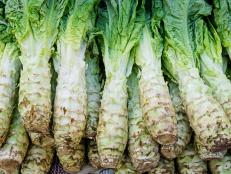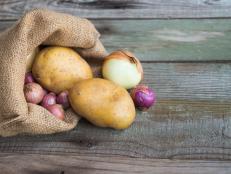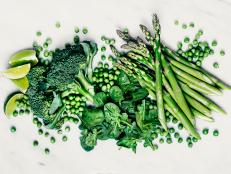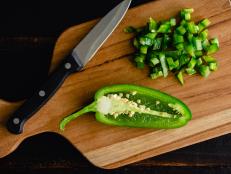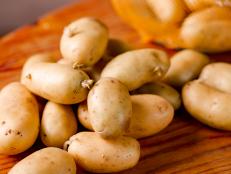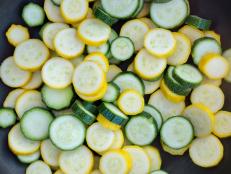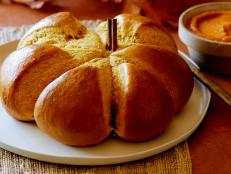What Foods Are High in Potassium?
We rounded up the standouts with high and low numbers.

Verdina Anna, 2013 Anna Verdina
What do guavas, sweet potatoes and bananas have in common? They’re all great sources of potassium. A wide variety of plant and animal foods contain potassium, as do many of beverages. Managing your potassium intake can help — or hurt your health.
You may be looking for ways help lower blood pressure without medication. Or maybe symptoms of the keto flu have got you down; eating more of the mineral potassium can help.
Eating more potassium-rich foods is a healthy idea for most people. Potassium helps regulate the fluid and mineral balance in and out of body cells. It also helps transmit nerve impulses and helps muscles contract. This electrolyte helps maintain normal blood pressure blunting sodium’s effect on blood pressure. For some, including those with chronic kidney disease, foods with lower amounts of potassium should be eaten.
Most healthy women over age 18 need 2,600 mg of potassium to avoid deficiency; or 2,900 mg while pregnant and 2,800 mg while lactating. Most men 18 years and older need 3,400 mg.
High-Potassium Healthy Foods
Following the Mediterranean Diet or the DASH Diet — both of which are rich in potassium — can help people get their blood pressure into a healthy range. Diets with plenty of potassium can also help lower the amount of blood pressure medication someone needs, or even help go off medication if health indicators improve, and a doctor approves it.
- Sweet potato, cooked (1/2 cup) – 475 mg
- Guava (2 small) – 460 mg
- Banana, medium – 420 mg
- Milk, 2% reduced fat (1 cup) – 380 mg
- Pinto beans, (frijoles cocidos) cooked (1/2 cup) – 371 mg
- Wild Alaska salmon (3 oz) – 370 mg
- Papaya (1 cup cubes) – 360 mg
- Tomatillos, fresh (1 cup) – 354 mg
- Potato, baked, with skin (2 oz) - 330 mg
- Bok choy, cooked (1/2 cup) – 315 mg
- Pistachios (1 oz) – 295 mg
- Plain yogurt, whole milk (6 oz) – 285 mg
- Whole wheat pasta (2 oz) – 274 mg
- Raisins (1/4 cup) – 270 mg
- Beef, lean (3 oz) – 267 mg
- Shrimp (3 oz) – 260 mg
- Pumpkin, canned (1/2 cup) – 250 mg
- Chickpeas, cooked (1/2 cup) – 240 mg
- Plantains, cooked (1/3 cup) 236 mg
- Orange, medium – 235 mg
- Turkey, light and dark meat, skinless (3 oz) – 225 mg
- Chicken, skinless (3 oz) – 210 mg
- Peanut butter (2 tablespoons) – 208 mg
Low-Potassium Healthy Foods
Following the Mediterranean Diet or the DASH Diet can also help people avoid potassium, if needed, but lower-potassium foods — with less than 200 mg per serving — should be swapped out for many of the foods found in the diets, including some fruits and vegetables, beans and legumes, yogurt and cheese, lean meats and some nuts.
- White rice (1/2 cup) – 27 mg
- Brown rice (1/2 cup) – 42 mg
- Tea (1 cup) - 45 mg
- Blueberries (1/2 cup) – 54 mg
- Tahini (1 tablespoon) – 60 mg
- Eggplant (1/2 cup) – 61 mg
- Bulgur wheat (1/2 cup) – 62 mg
- Barley (1/2 cup) – 75 mg
- Raspberries (1/2 cup) – 76 mg
- Cucumber (1/2 cup) – 80 mg
- Watermelon (1/2 cup) – 85 mg
- Grapes (1/2 cup) – 88 mg
- Green beans (1/2 cup) – 90 mg
- Strawberries (1/2 cup) – 100 mg
- Okra, cooked (1/2 cup) – 110 mg
- Coffee (1 cup) – 116 mg
- Tofu (3 oz) – 125 mg
- Regular pasta (2 oz) – 127 mg
- Turnips (1/2 cup) – 140 mg
- Cabbage (1/2 cup) – 150 mg
- Cauliflower (1/2 cup) – 150 mg
- Asparagus (1/2 cup) – 155 mg
- Dark chocolate (1 oz) – 158 mg
- Apple (small) – 160 mg
- Mango (half) – 162 mg
- Spinach, fresh (1 cup) – 170 mg
- Jicama, fresh (1 cup) – 180 mg
- Avocado (1/4 cup) – 185 mg
- Corn (1/2 cup) – 195 mg
Serena Ball, MS, RD is a registered dietitian nutritionist, food writer, and recipe developer. She blogs at TeaspoonOfSpice.com and is the author of the best-selling The 30-Minute Mediterranean Diet Cookbook. Follow her @TspCurry on Twitter and Instagram.

























